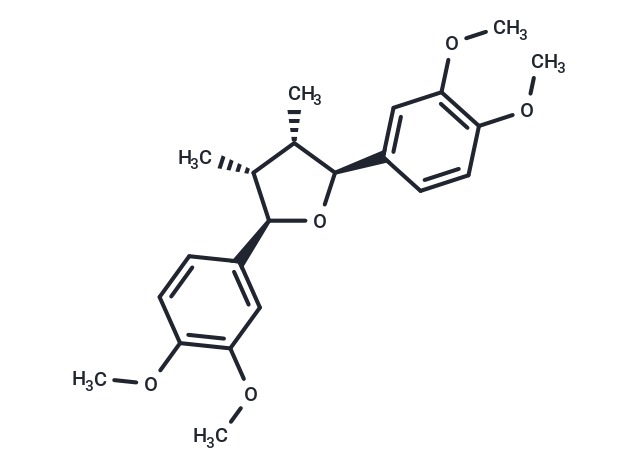Shopping Cart
- Remove All
 Your shopping cart is currently empty
Your shopping cart is currently empty

Galgravin has anti-inflammatory, and neuroprotective effects, it can promote neuronal survival and neurite outgrowth, protect hippocampal neurons against amyloid beta peptide (Abeta25-35)-induced cytotoxicity, and protect against neuronal death from 1-methyl-4-phenylpyridinium ion (MPP+)-induced toxicity in cultured rat hippocampal neurons.

| Pack Size | Price | Availability | Quantity |
|---|---|---|---|
| 1 mg | $217 | In Stock | |
| 5 mg | $540 | In Stock | |
| 10 mg | $779 | In Stock | |
| 25 mg | $1,180 | In Stock | |
| 50 mg | $1,620 | In Stock | |
| 100 mg | $2,180 | In Stock | |
| 1 mL x 10 mM (in DMSO) | $550 | In Stock |
| Description | Galgravin has anti-inflammatory, and neuroprotective effects, it can promote neuronal survival and neurite outgrowth, protect hippocampal neurons against amyloid beta peptide (Abeta25-35)-induced cytotoxicity, and protect against neuronal death from 1-met |
| In vitro | This approach resulted in the isolation and characterization of eight tetrahydrofuran neolignans: calopeptin (1), machilin-G (2), machilin-I (3), aristolignin (4), nectandrin A (5), veraguensin (6), ganschisandrin (7), and Galgravin (8). Different assays were conducted to evaluate their cytotoxic activities and to determine the possible mechanism(s) related to the activity displayed against human leukemia cells. The most active compounds 4, 5 and 8 gave IC50 values of 14.2 ± 0.7, 16.9 ± 0.8 and 16.5 ± 0.8 μg/mL, respectively, against human leukemia (HL-60) tumor cells. Moreover, these compounds induced specific apoptotic hallmarks, such as plasma membrane bleb formation, nuclear DNA condensation, specific chromatin fragmentation, phosphatidyl-serine exposure on the external leaflet of the plasma membrane, cleavage of PARP as well as mitochondrial damage, which as a whole could be related to the intrinsic apoptotic pathway. |
| Molecular Weight | 372.45 |
| Formula | C22H28O5 |
| Cas No. | 528-63-2 |
| Smiles | C[C@@H]1[C@H](O[C@H]([C@@H]1C)C2=CC(OC)=C(OC)C=C2)C3=CC(OC)=C(OC)C=C3 |
| Relative Density. | 1.082 g/cm3 (Predicted) |
| Storage | store at low temperature | Powder: -20°C for 3 years | In solvent: -80°C for 1 year | Shipping with blue ice. | |||||||||||||||||||||||||
| Solubility Information | DMSO: 9 mg/mL (24.16 mM), Sonication is recommended. | |||||||||||||||||||||||||
Solution Preparation Table | ||||||||||||||||||||||||||
DMSO
| ||||||||||||||||||||||||||

Copyright © 2015-2025 TargetMol Chemicals Inc. All Rights Reserved.